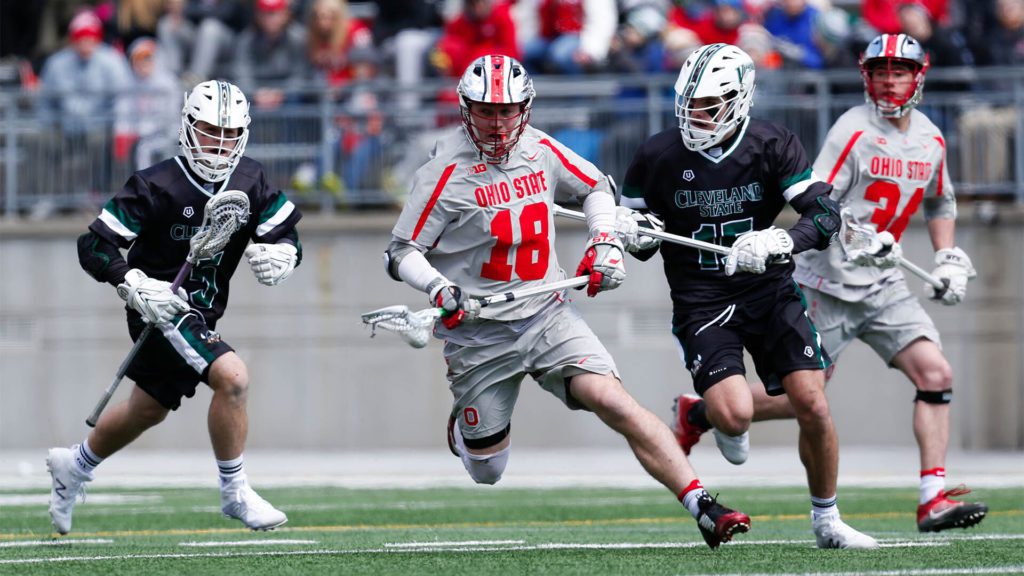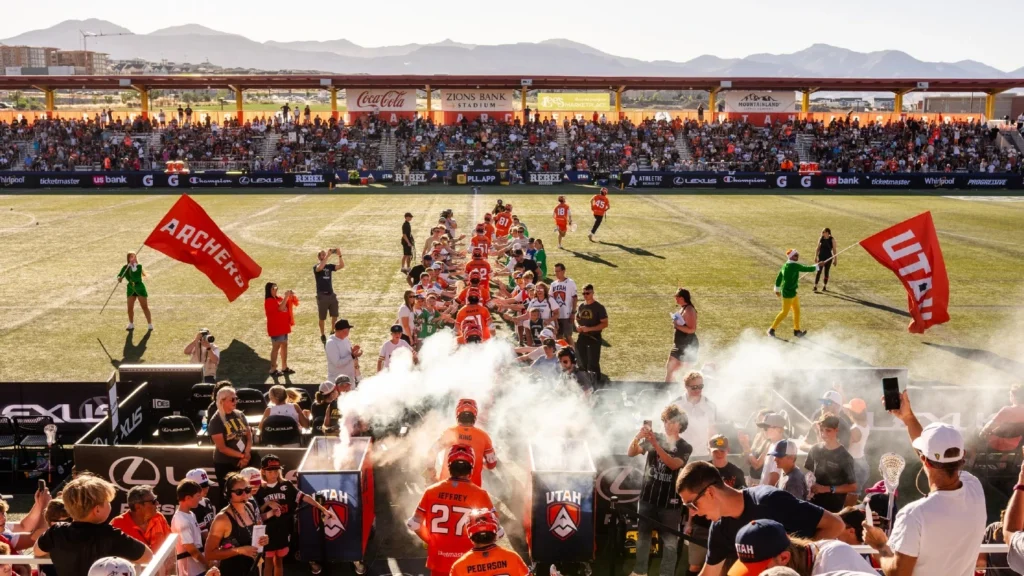
The Years that Morphed Jake Withers into a Potential Leader for the Waterdogs
By Josh Schafer
Jul 21, 2020
A figurine covers much of Jake Withers right tricep. The man, suited to box in the mid 20th century, could represent a lot of things to Withers, who once tuned up an opponent’s face to the point of hospitalization. Like the boxer on his shoulder, Withers is an agitator, known for his ability to frustrate opponents and counter their movements at the faceoff X.
But for Withers, this tattoo is an ode to his best friend, Jake Stanley, who died while Withers played lacrosse at Ohio State. This tattoo reminds Withers of Stanley, “a larger than life character,” who inspires you to keep pushing forward even after he’s gone.
“He was real resilient, never really gave up on anything,” Withers said.
When Withers walks to the stripe for his first faceoff in the PLL on July 26 on NBC at 4 p.m ET, the life adjustments that brought him to that moment will flash one after another. There’ll be subtle things, like the position of his knee and the direction of his foot, or the tattoo of Stanley, a reminder of his rugged Peterborough, Ontario roots. Beneath his helmet though, hidden from the cameras, they’ll be a staunch demeanor, one he fine-tuned while chasing the national championship he once promised Stanley and has pushed him into the conversation for best faceoff man in the world.
“He doesn't just give (the Waterdogs) a faceoff guy, he gives them an identity,” said Ohio State head coach Nick Myers. “He walks out there, like Jake Withers, that's a tough son of a b****...he walks out there, that’s an attitude.”
A 'Punk'
Understanding Jake Withers starts with understanding Peterborough, Ontario. Withers grew up about a 10-minute drive from the city in Keene, a town of fewer than 7,000 people. He spent his childhood playing pickup sports with other kids from the Peterborough era. The mini-stick lacrosse games were always full contact and Withers was more than willing to wrestle any of his buddies. On Thursdays, Withers, and friends like Zach Currier, who’s now a teammate with him on the Waterdogs, snuck in the back door of the Peterborough Memorial Centre to catch a glimpse of what Currier describes as “the best-kept secret in lacrosse.”
Like a hockey night in Canada, those box lacrosse games on Thursday night were everything in Peterborough. At one point, Currier drove 10 hours a week from Michigan so he could keep playing for the Peterborough Lakers. It’s just one of those areas where people rarely leave and those that do find a way back. It has all the common jobs of a big city, Currier said, electricians, construction workers, etc, just not all the white-collar jobs.
“There are not too many finance people coming into Peterborough and opening up shop,” Currier said. “It's a lot of trades, bars, and restaurants.”
Withers has played box lacrosse in Peterborough since he started playing the sport at seven-years-old. It’s what makes him a versatile player, someone that can stay on the field for early offense or guard a midfielder if he loses the faceoff. It also made him tough. Well-adjusted to playing in tighter quarters, Withers is known for being a ground ball vacuum (His 351 ground balls at Ohio State are a school record with the next closest player trailing by 155 GBs).
The box game, however, had an adverse impact when he arrived at Ohio State. Kids in the United States, grew up playing field lacrosse in which the faceoff specialist is more common. In box, Withers took faceoffs because he was one of more athletic players, not because he’d trained at the specialty craft for years.
His first two seasons at Ohio State, Withers won a notch more than 50 percent of his faceoffs. Serviceable, but not All-Conference type numbers. At that point, Withers' athleticism led to draw victories more than technical skill. He’d out hustle players to ground balls or counter their move after the clamp.
He played with a fire that helped him beat more talented players, Myers said, but he hadn’t opened up his mind to changing his style of play completely. Lost faceoffs bothered him a bit too much and his aggressive nature was out of control at times. It led to issues off the field as well.
Withers described his early Ohio State-self as a “punk.” He wanted to play Division-I lacrosse, sure, but he also wanted the college experience and all of the shenanigans that could include. During the fall before his sophomore year, Withers found himself in a “scrap at a bar.” There were no legal charges but Myers suspended Withers for two months.
“There was some rawness to him in terms of his edginess,” Myers said. “And sometimes what makes us great can also burn our house down.”
When Myers recruited Withers, the college lacrosse hopeful promised his future coach a national championship. Two years into their time together, Myers didn’t think Withers was committed to that goal. He needed to trust the Ohio State coaches and follow their guidelines.
“It was a good wake up call, a kind of kick in the ass, that was a long-time coming,” Withers said.
“In hindsight, it was kind of the best thing that could happen to me.”

Becoming a leader
Withers doesn’t remember the coaching visit that changed the trajectory of his career. It was sometime during his sophomore season and for some reason, he never met Greg Gurenlian in person that day.
Gurenlian, a former PLL All-Star and Team USA member, started The Faceoff Academy in 2012 and brought his expertise to Ohio State. His program emphasizes a shift in stance and optimizing body mechanics to limit unnecessary movements during faceoffs. Gurenlian asked the Ohio State staff that day who would commit themselves to his system. The coaches assured that Withers would. He had to.
Withers and Gurenlian formed an online relationship for Withers' final two years at Ohio State. After watching Withers film, Gurenlian saw parts of himself during the early part of his career. A self-taught faceoff man, Gurenlian relied on his athleticism to bail him out of poor mechanics. Withers was no different.
“I'm looking at this guy and I'm like wow he's getting away with backward mechanics just because he's so insanely athletic and blue-collar.” Gurenlian said.
Following his sophomore season, everything changed for Withers on the field. He switched his hands from a normal lacrosse grip to a motorcycle grip, which puts both hands on top of the stick with their knuckles facing the opponent. He adjusted his backfoot so his toes locked in at a sprinter position. With the foot movement, his weight distribution shifted toward the play, something he previously hadn’t done.
He perfected his counter moves too. One, known as a reverse shovel, became the bane of opposing coaches. A quick swipe lacrosse his opponents stick jarred the ball loose and turned what appeared like a faceoff loss into a Withers’ groundball. Coaches pleaded to refs that Withers was holding their faceoff guys, though he wasn’t. He’s just an agitator who knows what it’s like to be under someone’s skin.
After a summer of learning heading into his junior season, things suddenly stopped for Withers once more. His best friend, Jake Stanley died on September 12, 2015. For a moment it appeared all his work could’ve been for nothing.
“That was something that kicks you right in the pants, takes everything right out of you, right?” Withers said. “Especially when it's somebody that, (when) I'm down at school, I haven't thought of in a while, and a guy that I used to see almost every day in my life. It's something where I could've picked it up. I went home. I could've stayed there and you know kind of sank myself away, kind of back into where I was at the start of my sophomore year.”
Stanley had been one of Withers' biggest supporters, he constantly asked about the status of the season and when he’d be coming down for a national championship game. So instead of allowing his friend’s passing to derail him, Withers slapped his buddy on his arm with some ink and went back to chasing the national championship they’d always discussed.
Withers' adjustments from Gurenlian created an entirely new player. In his junior season, Withers won Big Ten Specialist of the Year, with a league-best 60.7% faceoff winning percentage and averaged more than seven ground balls per game. But Ohio State didn’t make the postseason.
Early on in his senior season, it appeared the Buckeyes were headed for a similar fate. Myers was at odds with his goalie Tom Carey, whose failure to listen and commit himself fully to the program’s plan had led two games on the bench. Withers went into a meeting with the two and explained to Carey that he too used to be that guy who always thought he was right. Once he swallowed his pride and trusted Myers' system, his play elevated.
“Jake's like a lot of athletes; he wanted to understand the why,” Myers said. “Once he understood kind of why we were doing things the way we were, he had no issue.”
After the talk, Carey went on to an All-American season, as did Withers who finished the season as a second-team All-American, winning 64.7 percent of his faceoffs. Ohio State lost in the Big Ten Championship to Johns Hopkins. Even in the program’s best year, they didn’t close out their league title. For a rising program, it could’ve been demoralizing. Withers addressed the team in the locker room.
“I want you guys to listen up, we're going to be dry the rest of his month,” he said. “We're going to make the NCAA tournament this weekend and we're going to play all the way through for a national championship.”
He was right. Ohio State lost in the National Championship. It took three opposing faceoff men to stifle Withers that day.
So, he didn’t come full circle on his talks with Stanley. Instead, he learned what being tough really meant. He saw he isn’t much different than the tattoo on his arm. He too is a fighter.
“(Stanley) just kind of taught me that no matter what's going on in your head, what's going on in life, big or small, you always just kind of pushing forward, keep trucking along,” Withers said.





Pingback: 배트맨토토
Pingback: microsoft exchange hosting plan
Pingback: rastrear celular
Pingback: lenovo servis
Pingback: how long does shrooms last
Pingback: คาสิโนออนไลน์เว็บตรง
Pingback: สล็อตวอเลท
Pingback: australia ecstasy pills for cats
Pingback: สล็อตวอเลท ไม่มีขั้นต่ำ
Pingback: visit here
Pingback: sbobet
Pingback: คลิปหลุด
Pingback: the drug ecstasy is most closely related to which of the following,
Pingback: บาคาร่า ขั้นต่ำ 5 บาท
Pingback: roasted portobello mushrooms
Pingback: Energy Plans in Northlake TX
Pingback: passive streams of income
Pingback: Alexa Nikolas divorce
Pingback: Trek Mountain Bikes
Pingback: mounjaro weight loss uk
Pingback: Kardinal Stick
Pingback: bonanza178
Pingback: รับเขียนโปรแกรม
Pingback: หวย LSM99
Pingback: Undressing AI
Pingback: iTune gift card
Pingback: รับติดตั้งระบบไฟฟ้า
Pingback: altogel
Pingback: อุปกรณ์ อุตสาหกรรม
Pingback: บริษัทรถเช่า
Pingback: arduino
Pingback: Guns For Sale
Pingback: https://stealthex.io
Pingback: รับสร้างบ้านเชียงใหม่
Pingback: เกียรติบัตรออนไลน์